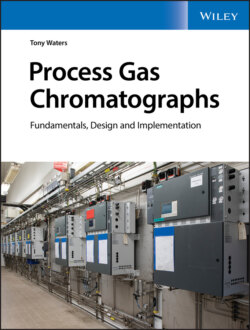Читать книгу Process Gas Chromatographs - Tony Waters - Страница 78
Student evaluation test: SET 03
ОглавлениеYour instructor will provide answers to these questions.
All of the questions relate to gas‐liquid chromatography.
1 S1. Which one of the statements below best defines the retention time of a component peak? Select one:It's the average time that the component molecules spend in the column.It's the average time that the component molecules spend in the gas phase.It's the average time that the component molecules spend in the liquid phase.It's the average time that the component molecules spend in the detector.
2 S2. Which one of the statements below best explains the separation of component peaks on the chromatogram? Select one:The molecules of some components move at different speeds than others do.The molecules of some components spend less time moving than others do.The molecules of some components spend more time moving than others do.The molecules of some components spend more time not moving than others do.
3 S3. Which one of the statements below best explains the significance of the air peak? Select one:The air peak marks the time when the component molecules start to dissolve in the liquid phase.The air peak indicates the time that every component molecule spends in the gas phase.The air peak indicates the time that every component molecule spends in the liquid phase.Any peaks traveling faster than the air peak cannot be separated on that liquid phase.
4 S4. On the chromatogram shown in Figure 3.3, what percentage of the 1‐butene dissolves in the liquid phase at equilibrium?
5 S5. If the holdup time on a certain column is sixty seconds, what would be the adjusted retention time of a peak having a liquid phase solubility of 60 %?Express your answer in integer seconds.
6 S6. If the propane peak has a retention time of sixty seconds on a three‐meter column and propane has a solubility in the column liquid phase of 50 %, what is the average velocity of the carrier gas?Express your answer in m/s.
7 S7. Why do peaks that are evenly spaced in the column turn out to be unevenly spaced on the chromatogram? Combine two of the arguments given below to get the best overall explanation.Select two:All of the peaks spend the same time in the carrier gas.The later peaks are more soluble in the liquid phase than the earlier peaks are.After the air peak reaches the end of the column, the later peaks have farther to go than the earlier peaks do.The later peaks migrate through the column more slowly than the earlier peaks do.
8 S8. This question asks you to make logical deductions beyond what you learned in the chapter.Assuming that all other variables can be held constant, evaluate whether each statement listed below is true or false.Select all of the true statements and none of the false statements:The holdup time would be proportional to the column length.The retention time of a component peak would be proportional to the column length.If the carrier gas flow increased, the holdup time would increase.If the column temperature increased, the adjusted retention time of a component peak would decrease.None of the statements A−D above are true.
9 S9. This question asks you to make logical deductions beyond what you learned in the chapter.Consider a column that loses some of its stationary phase due to slow evaporation, but all other variables are held constant. Then, evaluate whether each statement listed below is true or false.Select all of the true statements and none of the false statements:The holdup time would be reduced.The retention time of all peaks would be reduced.The adjusted retention time of all peaks would be reduced.The separation of component peaks would be increased.None of the statements A−D above are true.
